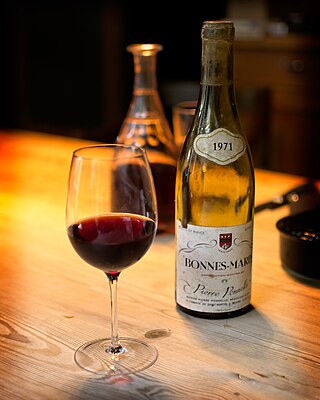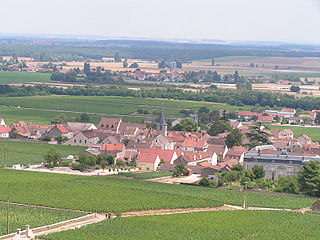Related Research Articles

Clos de Vougeot, also known as Clos Vougeot, is a wall-enclosed vineyard, a clos, in the Burgundy wine region, and an Appellation d'origine contrôlée (AOC) for red wine from this vineyard. It was named for the River Vouge, which is in fact only a stream separating the village Vougeot from Chambolle-Musigny. At 50.6 hectares, Clos de Vougeot is the largest single vineyard in Côte de Nuits entitled to the grand cru designation, while Corton in Côte de Beaune is the largest grand cru in Burgundy as a whole.

Bonnes Mares is an Appellation d'origine contrôlée (AOC) and Grand Cru vineyard for red wine in the Côte de Nuits subregion of Burgundy, with Pinot noir as the main grape variety. The AOC was created in 1936. It is shared between the two communes of Chambolle-Musigny and Morey-Saint-Denis in the Côte-d'Or département. Bonnes Mares is located a little to the north of the Chambolle-Musigny village, and borders the Route des Grands Crus in the east and the Grand Cru vineyard Clos de Tart in the north.

Chambolle-Musigny is a commune in the Côte-d'Or département in eastern France.

Vosne-Romanée is a commune in the Côte-d'Or department in Bourgogne-Franche-Comté in eastern France.

La Grande Rue is an Appellation d'origine contrôlée (AOC) and Grand Cru vineyard for red wine in the Côte de Nuits subregion of Burgundy, with Pinot Noir as the main grape variety.

The Côte de Nuits is a French wine region located in the northern part of the Côte d'Or, the limestone ridge that is at the heart of the Burgundy wine region. It extends from Dijon to just south of Nuits-Saint-Georges, which gives its name to the district and is the regional center. Though some white and rosé wines are produced in the region, the Côte de Nuits is most famous for reds made from pinot noir. The Côte de Nuits covers fourteen communes. Six produce grand cru wines, in the central district between Gevrey-Chambertin and Nuits-Saint-Georges, with four lesser villages either side. The Grand Crus of the Côte de Nuits are some of the smallest appellations in France, less than a hectare in the case of La Romanée.

The Route des Grands Crus is the name of a tourist route situated in Burgundy, France.

Romanée-Saint-Vivant is an Appellation d'origine contrôlée (AOC) and Grand Cru vineyard for red wine in the Côte de Nuits subregion of Burgundy, with Pinot noir as the main grape variety. It is situated within the commune of Vosne-Romanée. La Romanée borders on La Grande Rue in the south, Romanée-Conti and Richebourg in the west, Vosne-Romanée Premier Cru vineyards in the north and in the east and also the village Vosne-Romanée itself in the east. The AOC was created in 1936. It takes its name from the Abbey of Saint Vivant, which in Medieval times owned several vineyards among the Vosne-Romanée Grands Crus.

Romanée-Conti is an Appellation d'origine contrôlée (AOC) and Grand Cru vineyard for red wine in the Côte de Nuits subregion of Burgundy, France, with Pinot Noir as the primary grape variety. It is situated within the commune of Vosne-Romanée and is a monopole of the winery Société Civile du Domaine de la Romanée-Conti, which takes its name after this vineyard. Romanée-Conti borders on La Romanée in the west, Richebourg in the north, Romanée-Saint-Vivant in the east and La Grande Rue in the south. The AOC was created in 1936.

Échezeaux is an Appellation d'origine contrôlée (AOC) and Grand Cru vineyard for red wine in the Côte de Nuits subregion of Burgundy, with Pinot noir as the main grape variety. Échezeaux is located within the commune of Flagey-Echézeaux, on a strip of land between the territory of the communes Vosne-Romanée, Vougeot and Chambolle-Musigny. Échezeaux borders on the Clos de Vougeot and its wall as well as Grands Échezeaux in the east, on Chambolle-Musigny vineyards in the north, some Vosne-Romanée vineyards in the west and on the Vosne-Romanée Premier Cru vineyard Les Suchots in the south. The AOC was created in 1937.
Musigny, sometimes referred to as Le Musigny, is an Appellation d'origine contrôlée (AOC) and Grand Cru vineyard for red and white wine in Côte de Nuits of Burgundy. It is located within the commune of Chambolle-Musigny, to the south of the village itself. It borders on the Grand Cru Clos de Vougeot in the southeast, the Grand Cru Échezeaux in the south, and the Premier Cru Les Amoureuses in the northeast. The name is derived from a family de Musigny which is now extinct, but which held offices in the court of the Dukes of Burgundy from the 14th century. The AOC was created in 1936, but the borders of Musigny were previously set down legally in 1929.

Grands Échezeaux is an Appellation d'origine contrôlée (AOC) and Grand Cru vineyard for red wine in the Côte de Nuits subregion of Burgundy, with Pinot noir as the main grape variety. Grands Échezeaux is located within the commune of Flagey-Echézeaux, on a strip of land between the territory of the communes Vosne-Romanée, Vougeot and Chambolle-Musigny. Grands Échezeaux borders on Clos de Vougeot and its wall in the east and north, and on Échezeaux in the west and south. The AOC was created in 1936.

La Tâche is an Appellation d'origine contrôlée (AOC) and Grand Cru vineyard for red wine in the Côte de Nuits subregion of Burgundy, with Pinot noir as the main grape variety. It is situated within the commune of Vosne-Romanée and is a monopole of the winery Domaine de la Romanée-Conti. La Tâche borders on La Grande Rue in the north, and mostly on Vosne-Romanée Premier Cru vineyards in the east, south and west. The AOC was created in 1936.

Vosne-Romanée wine is produced in the commune of Vosne-Romanée in Côte de Nuits of Burgundy as well as in the neighbouring commune of Flagey-Échezeaux. The Appellation d'origine contrôlée (AOC) Vosne-Romanée may only be used for red wine with Pinot noir as the main grape. There are a total of 15 Premier Cru vineyards in the two communes, as well as six Grand Cru vineyards in Vosne-Romanée and two in Flagey-Échezeaux. These Grand Cru vineyards include Burgundy's most iconic, sought-after and expensive red wines, with Romanée-Conti of Domaine de la Romanée-Conti at the pinnacle: "There can be little doubt that in the firmament of the Cote de nuits, Vosne-Romanée is the brightest star."

Domaine Faiveley is a wine producer in Burgundy, France situated in Nuits-Saint-Georges and established in 1825. Faiveley also runs a négociant business, but this activity is much smaller in volume than the wine production from their own vineyards.

Domaine de la Romanée-Conti, often abbreviated to DRC, is an estate in Burgundy, France that produces white and red wine. It is widely considered among the world's greatest wine producers, and DRC bottles are among the world's most expensive. It takes its name from the domaine's most famous vineyard, Romanée-Conti.

Domaine Ponsot is a wine producer in Burgundy, France that produces white and red wine. They are best known for their Morey-Saint-Denis Blanc 1er cru Clos des Monts Luisants — the only premier cru Burgundy made entirely from Aligoté — and their flagship reds, the Clos de la Roche Cuvée Vieilles Vignes, and the Clos St. Denis Cuvée Très Vieilles Vignes. The domaine's wine was famously counterfeited in the Wine Auction Scandal that resulted in Rudy Kurniawan's arrest.
Domaine de la Vougeraie is a Burgundy wine producer in the town of Premeaux-Prissey, France. They produce wine from vineyards in the Côte de Nuits and the Côte de Beaune.
References
- ↑ Morris, Jasper (2021). Inside Burgundy (2nd ed.). London: Berry Bros. & Rudd Press. pp. 275–276.
- 1 2 "Domaine Dujac". Wine Anorak. Retrieved 8 July 2012.
- ↑ "Domaine Dujac - producer profile". Wine-Searcher. Retrieved 2023-09-28.
- ↑ "Domaine Dujac". www.dujac.com. Retrieved 2023-09-28.
- ↑ "Domaine Dujac". www.dujac.com. Retrieved 2023-09-28.
- 1 2 3 4 5 Coates, Clive. "Dujac". Archived from the original on 14 July 2017. Retrieved 8 July 2012.
- ↑ Morris, Jasper (2010). Inside Burgundy. Berry Bros. & Rudd Press. p. 172. ISBN 978-0-9510632-1-7.
- 1 2 3 "Profile: Domaine Dujac". Burgundy Report. 31 July 2009. Retrieved 9 July 2012.
- ↑ "Domaine Dujac". Bergman's Bourgogne – Appetite for Burgundy. Retrieved 2023-09-28.
- 1 2 "Domaine Dujac". www.dujac.com. Retrieved 2023-09-28.